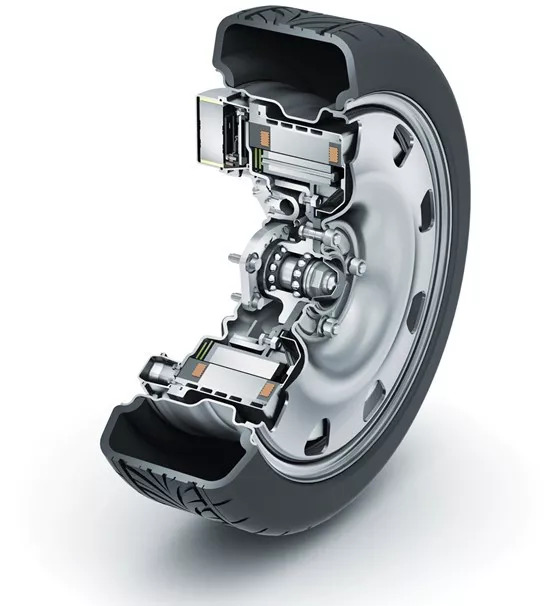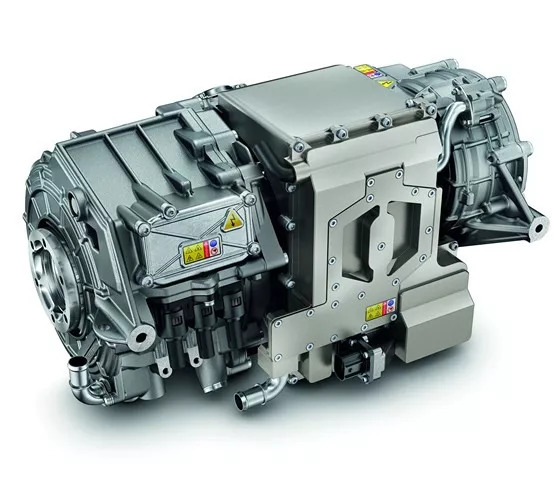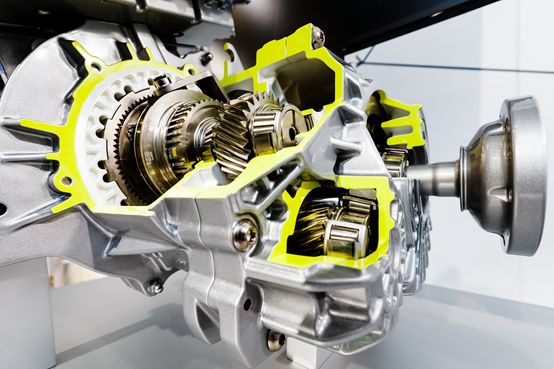 以机械零部件起家的舍弗勒正在大力扩大版图,雄心壮志从Bio Hybrid微交通概念车中可见一斑。舍弗勒已在筹备该车型的投产。
以机械零部件起家的舍弗勒正在大力扩大版图,雄心壮志从Bio Hybrid微交通概念车中可见一斑。舍弗勒已在筹备该车型的投产。 舍弗勒认为,轮毂电机将会颠覆电动汽车架构
舍弗勒认为,轮毂电机将会颠覆电动汽车架构 纯电动车桥融合了舍弗勒在内燃机传动系统上积累的经验和新的电动技术。
纯电动车桥融合了舍弗勒在内燃机传动系统上积累的经验和新的电动技术。 48伏驱动桥是舍弗勒实现全面混动化愿景的途径之一。
48伏驱动桥是舍弗勒实现全面混动化愿景的途径之一。
说到汽车行业的有机技术转型,可能没有比当下的舍弗勒更鲜明的例子了。每每谈到变速箱系统的关键基本技术时,“舍弗勒”的名字肯定会被提及。通用全球推进系统的一位工程师最近在接受采访时,就提到通用正在和舍弗勒一同为通用全新8速自动变速箱研发一款新型减震器。该款减震器将根据传动系控制器输出扭矩转换器的打滑程度,来调节减震效果。
舍弗勒集团旗下拥有FAG和LuK两大品牌。FAG历史悠久,长达113年,主要产品为特色轴承和离合器。LuK则专门生产摩擦材料。可见奠定舍弗勒根基的,还是内燃机的相关基础技术。
既然如此,舍弗勒又为什么要在年初在硅谷建厂,又新增一个电动汽车业务部门呢?
对此,舍弗勒美国区副总裁、首席技术官Jeff Hemphill在最近接受《汽车工程》杂志的采访时风趣地答道,“我们是尝试一条新路。舍弗勒的技术基石是带保持架的滚针轴承,而这可以说是电子技术应用最少的部件了。”
如今,几乎所有跨国供应商都是句句不离电动化。业务涵盖传统车型和混动车型的舍弗勒,在研发新品、分析测试变速箱、发动机、底盘零部件系统时,自然也会涉猎电动技术和功能。
说是“全新”,其实不然
Hemphill说道,其实“传统”机械零部件系统供应商很多年前就已经开始研究电动化了,这点大家都清楚,“10年前,甚至是15年前,我们就已经开始研发所谓的‘机械电子’驱动系统。刚开始是变速箱,现在拓展到了发动机。比如在双离合变速箱执行机构技术方面,我们就投入了很多精力。”
“我们研发的是装有微型控制器和软件的智能执行机构,可以显示功能性安全读数和其他参数。而我们现在的产品在保留了所有机械元素的基础上,还增加了印刷电路板、传感器和软件。”
“我们其实在机电一体化上已经积累了丰富的经验。我们在机械技术方面的背景让我们获益良多。舍弗勒在一体化技术方面的经验,是我们最引以为豪的优势之一。我们正在开发一款针对该市场的全新混合动力模块。从零件到系统层面,我们将结合工程师和生产部门的力量,思考全新的整合方式。”
“这一直是我们的一大优势。借助这一优势,我们新模块的最终轴长比客户要求的还要短60毫米。我们本来就在生产扭矩转换器,所以我们可以研究用不同的方式连接转换器和电机,这样节约了不少的空间。可见,我们在机械技术方面的积累,对于公司的电气化和机电一体化转型也不是完全无益的。”
一个词:软件
Hemphill表示,对于舍弗勒而言,进一步发展机电一体化,需要借助另一项重要技术的发展——软件和相关电控技术,该技术对汽车业建立全新的整合型商业模式而言至关重要。难道说,完全整合供应商现在必须具备软件开发能力了吗?
对此,Hemphill解释道,“这取决于产品。比如,针对不同的执行机构或模块产品,供应商和整车厂到底谁来开发软件,或者开发多少,答案是不一样的。”
“针对有些执行机构,我们只需要根据整车厂给定的位置提供简单的接口,他们说需要装在扭矩阀,那我们就做扭矩阀执行机构。但对于另外一些设备,我们会起到更多的主导作用,这完全取决于项目内容。当然,我们现在也有数百名软件工程人员。确切有多少人,软件开发又到底占我们研发经费多少,准确的数字我要去查一下。不过,虽然软件开发很重要,但它不是我们的研发重点。”
舍弗勒坐拥强大的研发实力,Hemphill自己就拥有100多项专利,一些已颁发,一些仍在申请中。他说,目前舍弗勒在全球各地拥有超过6000多名研发人员。他解释道,对于当今的主要供应商而言,研发工作其实包含两部分,一是为推动企业发展而不断研发,二是为满足客户需求而改进创新。
“我认为两者是相互交融的,”他说,“我们当然以我们的创新实力为傲。这些年来,我们也在不断进取。我们的零部件涵盖了整个传动系统甚至整个车身,这就让我们可以从系统的高度看待问题,进而找到独特的解决方案。”
“我们会经常展示这些解决方案。我们已经在全球各地做了很多样车展示,有一些样车是我们和整车厂合作研发的。有时候,整车厂会先提出一个想法,我们再在此基础上延伸,将这个想法付诸实践。所以这是相互合作。我们很高兴能有所贡献。但是,现在单靠一家整车企业或一家供应商,是无法应对汽车行业所面临的挑战的。大家都在绞尽脑汁地思考出路。”
在科技圣地立足
舍弗勒最近在硅谷建立了圣何塞新厂。此举似乎也表明,不仅是在电动化,舍弗勒在各个方面都是不甘落后。尽管面对席卷而来的电气化和自动化浪潮,舍弗勒目前最显著的研发成果还只是一体化轮毂电机,但是Hemphill相信,在加利福尼亚的技术大本营建厂是正确的选择,这将帮助舍弗勒探索并研究新的商业模式。
“硅谷有着无限的创意。如果你能发现一两个好的、正确的想法,再帮助它们成型,那么最终你可能会成就一番大事。或者,我们也能找到一些初创公司,他们的技术正好是我们需要的。”
“毋庸置疑,混动化电动车出行是一个蒸蒸日上的领域,这也是我们主要的项目研究课题。但与此同时,我们还是保留了部分研发精力,用于最前沿的自由研发。我们希望在跟紧潮流的同时也能勇立潮头。”
“我们非常看好纯电动汽车。我记得有一组预测数据提到,2030年前美国的纯电动汽车市场普及率将达到约25%,全球范围的普及率会更高。所以我们十分看好电力驱动系统。毕竟和添加一排气缸相比,增加电机长度的难度要小很多。”
但是Hemphill也强调,“这也意味着未来大约70%的汽车即使装有电机,也依然会搭载内燃机和相应的变速箱。传统发动机在很长一段时间内都不会消失,只是所占比例或多或少的差别。内燃机可能会和电机一起使用,我们要做好两手准备,研发一体化的智能系统。”
他补充道,自动驾驶的未来也差不多如此:
“前不久,我们在德国巴登巴登的技术会议上推出了‘eCorner’的概念,其中包含了一体化轮毂电机,这是专门为机器人出租车、配送车等自动驾驶汽车而设计的。我们马上就会分拆出一家子公司来生产我们的微交通Bio Hybrid概念车。”
“未来有无限的可能。舍弗勒想力争上游,能更快地判断未来的发展方向,找到我们的立身之处。”
There might be few more incisive examples of the industry’s organic technology transformation than what’s going on with Germany’s Schaeffler. The company’s name invariably arises in discussion of key baseline technology for all manner of driveline systems. An engineer from GM’s Global Propulsion Systems, for example, recently noted that GM collaborated with Schaeffler for development of an innovative damper for GM’s new 8-speed automatic transmission that varies its effect based on the amount of torque-converter slippage dictated by the powertrain controller.
The Schaeffler Group includes the 113-year-old FAG brand that’s intimately associated with specialty bearings and clutch and friction-material specialist LuK. Schaeffler’s foundation essentially rests on the “basics” of internal combustion-related technology.
Then what’s the idea with bricks-and-mortar in Silicon Valley and a new e-mobility business unit, both established early this year?
“Well, we're certainly on a journey,” said Jeff Hemphill, Vice-President and Chief Technical Officer of the Schaeffler Group for the Americas, in a recent interview with Automotive Engineering. “The technical founding of the company is the cage-guided needle roller bearing—it's about a least-electronic product you could think of,” he quips.
But with responsibility for new-product development, analysis and testing of transmission, engine and chassis components and systems for conventionally- and hybrid-powered vehicles, Hemphill and Schaeffler are enmeshed in the adoption of electrified technology and features that has become the byword of almost all major multinational suppliers.
What’s ‘new’ isn’t, really
It’s of course no secret, said Hemphill, that suppliers of “traditional” mechanical components and systems have for years been electrifying: “It's been 10 or 15 years, probably, that we got into what you would probably call ‘mechatronics’ or lead systems. That was started on the transmission side and now also on the engine side. We do a lot of actuation for dual-clutch transmissions, for example.
“And those are smart actuators with embedded microcontrollers and software and functional safety readings and the whole works. So, we now have a product that got our mechanical bits in it but, also has a printed circuit board and sensors and software with it.
"So we actually have quite a lot of experience with that. And, our mechanical background has really helped us with that. One of the things that we're most proud of is our degree of integration. One of our new [developments] is a hybrid module for this market. We can get the design engineers together and the production people together from all the little bits as well as from the system level—and think about new ways to integrate them.
“That has been for us pretty powerful. In that hybrid module, for example, it allowed us to take out, I want to say, 60 mm of axial length compared to the customer's original request—just because we [already] make the torque converters. And we were therefore able to figure out a different way to connect it to the electric motor that took out a lot of space. So, it did turn out not to be that bad of a background for an electrical and mechatronic company.”
One word: software
For Schaeffler, the process of evolving mechatronics effectively led to another important evolution, said Hemphill: development of software—as well as associated electronics-controls “skills”—vital for the new integrated business models the auto sector has come to demand. Is it now inescapable that it’s incumbent on fully-integrated suppliers to have software-development competency?
“It varies by what product we're talking about,” Hemphill explained. “For some of our actuators [and other modules], let’s say, there's a line drawn, usually, between the supplier and the OEM who does how much of the software.
“Some of our actuators, we just provide a simple interface where they can tell us, for example, a torque value and we go to that torque; and in some of them, we have much more ownership of the control strategy and so on. It just depends on the project, but we certainly have hundreds of people doing software now. I could look up an exact number, or what percent of our R&D is doing software; it's important, but it's still not the majority of our R&D force.”
Hemphill, himself holder of more than 100 issued or filed patents, said Schaeffler’s global R&D workforce currently numbers well more than 6000 persons. For major suppliers, he explained, today’s R&D environment is comprised of internally-driven research and response to customer requests for certain developments or innovations.
“I would say it's a combination of both,” he said. “We're certainly proud of our innovative capacity. And we also have developed over the years—because we make parts throughout the powertrain or even throughout the vehicle—we can take system-level perspective on things and sometimes arrive at some unique solutions.
“We'll often demonstrate those solutions. We have a number of demonstration vehicles all around the world that we've shown off; a couple of them we actually did in conjunction with OEMs. And then sometimes the OEM will come to us with an idea, and we'll take that on and execute it. So, it's a mix and we're pretty happy with our contribution there. But the challenges facing the industry go beyond any one OEM or multiple OEMs and one supplier. We're all thinking our brains out here.”
Proximity to tech
Schaeffler’s new Silicon Valley site in San Jose seems to be evidence of the company’s intent to keep pace—and not necessarily just with electrification. Although integrated wheel-hub motors are one of the company’s most-visible developments aimed at the coming twin wave of electrification and automation, Hemphill believes being in California’s tech nest is the right move to help identify and analyze new business models, Hemphill said.
“Out in the Valley there is someone thinking about everything. If you can pick out a couple [ideas] that end up being right and help them get going, you can really be part of something big. And the other side of that is there may be startups we find that have technology that we need.
“e-Mobility hybridization in electric vehicles is certainly a growing area. And probably the bulk of our projects are dedicated to those. But we do keep a certain piece of R&D forward-focused in free-thinking kind of research and advanced development just to make sure that we're trying to lead the curve as well as keeping up with it.
“We're pretty bullish on full-electric vehicles. We do have a U.S. forecast number that shows something in the mid-20s [percent market penetration], I think, by 2030 for pure electric vehicles and more than that globally. So, we're believers in electric propulsion systems. It is a lot easier to add lengths to an electric motor than to add a bank of cylinders to an engine!
“But even with those numbers, that means that 70-some percent of the vehicles will still have a combustion engine and therefore some form of transmission with it—even if it has an electric motor on board. It's almost a matter of degree where the combustion engine will be around for a long time. It may have an electric motor with it. We have to be prepared to engineer both of those and put them together into an intelligent system,” Hemphill asserted.
And it’s a similar outlook for autonomy, he added:
“One of the concepts we just showed in our technical symposium in Baden-Baden we call the eCorner. It has an integrated electric wheel motor; it’s specifically designed for autonomous—you could say robo-taxis or delivery vehicles. And we're just about to spin off a company to produce our Bio Hybrid [micro-mobility concept vehicle].
“There's every possibility out there. We basically just want to be close to the leading edge and have an earlier chance to assess where it might go and not go—and where to get involved.”
Author: Bill Visnic
Source: SAE Automotive Engineering Magazine
等级
打分
- 2分
- 4分
- 6分
- 8分
- 10分
平均分
- 作者:Bill Visnic
- 行业:汽车
- 主题:管理与产品开发制造零部件质量、可靠性与耐久性车辆与性能
